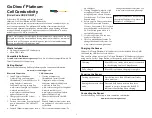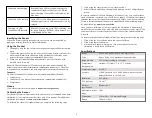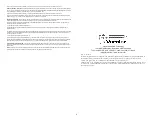
4
l
If you are taking readings at temperatures below 15°C or above 30°C, allow
more time for the temperature compensation to adjust and provide a stable
conductivity reading.
l
When you have finished using Go Direct Platinum-Cell Conductivity,
simply rinse it off with distilled water and blot it dry using a paper towel or
lab wipe. The probe can then be stored dry.
l
If the probe cell surface is contaminated, soak it in water with a mild
detergent for 15 minutes. Then soak it in a dilute acid solution (0.1 M
hydrochloric acid or 0.5 M acetic acid works well) for another 15 minutes.
Then rinse it well with distilled water and blot dry.
Important:
Avoid
scratching the inside electrode surfaces of the elongated cell.
l
When using the Platinum-Cell Conductivity Probe with other Vernier
sensors, some combinations of sensors interfere with each other when placed
in the same solution. The degree of interference depends on many factors,
including which combination of sensors is being used, which interface is
being used, among others.
For additional troubleshooting and FAQs, see
Sampling in Streams and Lakes
It is best to sample away from shore and below the water surface, if possible. In
free-flowing streams, there will usually be good mixing of the water, so that
samples taken near the current will be quite representative of the stream as a
whole. If you are sampling an impounded stream or a lake, there will be very
little mixing; therefore, it is important to sample away from shore and at
different depths, if possible. Do not drop Go Direct Platinum-Cell Conductivity
so that the entire electrode is submerged. The electrode is not constructed to
withstand higher pressures, so seepage into electronic components of the
electrode will result. Although it is better to take readings at the collection site,
readings of total dissolved solids or conductivity should not change
significantly if you collect samples and take readings at a later time. However,
be sure that samples are capped to prevent evaporation.
If sample bottles are filled brim full, then a gas such as carbon dioxide, which is
capable of forming ionic species in solution, is prevented from dissolving in the
water sample. Since the probe has built-in temperature compensation, you can
do your calibration in the lab. This means that even though you will be
sampling in water that has a different temperature than your calibration
temperature, the probe will take correct readings at the new sampling
temperature.
Sampling in Ocean Water or Tidal Estuaries: Salinity
Salinity is the total of all non-carbonate salts dissolved in water, usually
expressed in parts per thousand (1 ppt = 1000 mg/L). Unlike chloride (Cl
-
)
concentration, you can think of salinity as a measure of the total salt
concentration, comprised mostly of Na
+
and Cl
-
ions. Even though there are
smaller quantities of other ions in seawater (e.g., K
+
, Mg
2+
, or SO
4
2-
), sodium
and chloride ions represent about 91 percent of all seawater ions. Salinity is an
warmed to 25°C. This means you can calibrate your probe in the lab, and then
use these stored calibrations to take readings in colder (or warmer) water in a
lake or stream.
If you are testing a non-aqueous solution and want temperature-compensated
readings, you have to perform your own temperature standardization curve or
research the value. Some values are presented in Table 1. If the 0% temperature
compensation setting is selected, the probe is not temperature compensated and
you will notice a change in the conductivity reading as temperature changes,
even though the actual ion concentration does not change. This setting allows
you to investigate conductivity as a function of temperature.
Table 1
A sample of some typical temperature coefficients and corresponding
conductivities
Sample
Conductivity, μS/cm
% change/°C (at 25°C)
Ultrapure Water
0.055
4.55
Drinking Water
50–500
2.00
0.1% NaCl
1990
2.12
0.03% NaOH
1780
1.72
20% Acetic Acid
1600
1.56
5% NaOH
223,000
1.72
10% HCl
700,000
1.32
Troubleshooting
When testing Go Direct Platinum-Cell Conductivity, it is best to measure a
standard solution because it is easier to determine if the sensor is reading
correctly. If your Go Direct Platinum-Cell Conductivity is reading differently
from the standard solution, you may simply need to calibrate the sensor. See the
Calibrating the Sensor section for more information. Here are some other tips to
ensure best data collection practices:
l
Blot the inside and outside of the electrode cell dry to avoid water droplets
diluting or contaminating the sample to be tested.
l
Be sure the electrode surfaces in the elongated cell are completely
submerged in the liquid and that there are no bubbles around the electrode
surface.
l
Gently swirl the probe, or stir the solution with a stirring bar and stir plate,
during data collection.
l
Do not completely submerge the sensor. The handle is not waterproof.
























